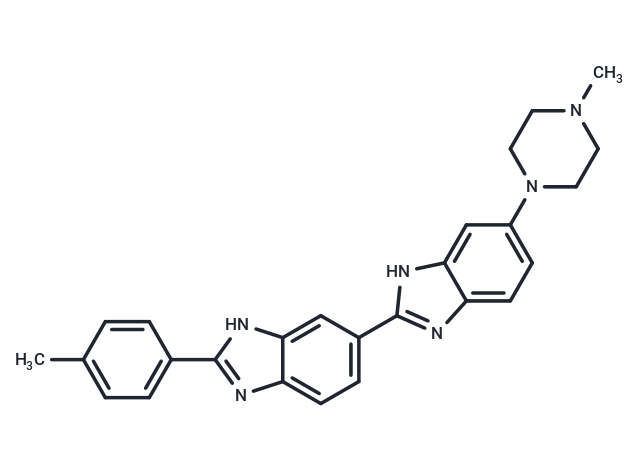Shopping Cart
Remove All Your shopping cart is currently empty
Your shopping cart is currently empty
Hoechst 33258 analog 3 is part of a family of blue fluorescent dyes used to stain DNA.

| Pack Size | Price | USA Warehouse | Global Warehouse | Quantity |
|---|---|---|---|---|
| 1 mg | $68 | - | In Stock | |
| 5 mg | $139 | - | In Stock | |
| 10 mg | $209 | - | In Stock | |
| 25 mg | $333 | - | In Stock | |
| 50 mg | $475 | - | In Stock | |
| 100 mg | $638 | - | In Stock | |
| 200 mg | $833 | - | In Stock |
| Description | Hoechst 33258 analog 3 is part of a family of blue fluorescent dyes used to stain DNA. |
| In vitro | The dyes Hoechst 33258 and Hoechst 33342 are the ones most commonly used and they have similar excitation/emission spectra. Both dyes are excited by ultraviolet light at around 350 nm, and both emit blue/cyan fluorescent light around an emission maximum at 461 nm. Unbound dye has its maximum fluorescence emission in the 510-540 nm range. Hoechst dyes are soluble in water and in organic solvents such as dimethylformamide or dimethyl sulfoxide. Concentrations can be achieved of up to 10 mg/mL. Aqueous solutions are stable at 2-6 °C for at least six months when protected from light. For long-term storage, the solutions are instead frozen at ≤-20 °C. Although the dyes can bind to all nucleic acids, AT-rich double-stranded DNA strands enhance fluorescence considerably. Hoechst dyes are cell-permeable and can bind to DNA in live or fixed cells. |
| Cell Research | Instructions 1. Dissolution and dilution: Hoechst 33258 Analog 3 is usually dissolved in DMSO (if applicable) or PBS. Before use, the dye can be diluted according to the concentration recommended by the manufacturer. The generally recommended staining concentration is 10ug/ml, and the specific concentration needs to be optimized according to the experimental requirements. 2. Staining steps: a. Fixation: If cells need to be fixed (for example, with formaldehyde or ice-cold methanol), fix them first. b. Staining: Add an appropriate amount of Hoechst 33258 Analog 3 solution to the cell culture plate and stain for about 15-30 minutes at room temperature. c. Rinse: Gently wash the cells with PBS or an appropriate buffer to remove unbound dye. 3. Fluorescence microscopy: The stained cells can be observed under ultraviolet light. Hoechst 33258 Analog 3 emits blue fluorescence, usually with an excitation light of 360-380 nm and an emission light in the range of 450-470 nm. |
| Molecular Weight | 422.52 |
| Formula | C26H26N6 |
| Cas No. | 23554-98-5 |
| Smiles | CN1CCN(CC1)c1ccc2nc([nH]c2c1)-c1ccc2nc([nH]c2c1)-c1ccc(C)cc1 |
| Relative Density. | no data available |
| Storage | keep away from direct sunlight | Powder: -20°C for 3 years | In solvent: -80°C for 1 year | Shipping with blue ice/Shipping at ambient temperature. | |||||||||||||||
| Solubility Information | DMSO: 3.57 mg/mL (8.45 mM), Sonication and heating to 70℃ are recommended. | |||||||||||||||
Solution Preparation Table | ||||||||||||||||
DMSO
| ||||||||||||||||
| Size | Quantity | Unit Price | Amount | Operation |
|---|

Copyright © 2015-2026 TargetMol Chemicals Inc. All Rights Reserved.